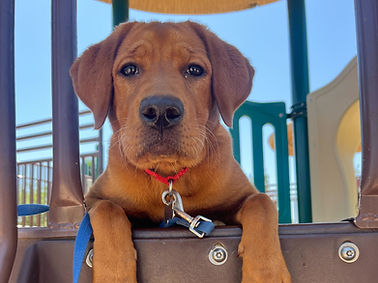Our Dogs In Training
Check out our dogs currently being taught by the incarcerated dog handlers at California Men's Colony in San Luis Obispo and learn about how our dogs can help Veterans and First Responders living with PTSD.

.jpg)
Paul
Hi everyone! My name is Paul and I'm a Red lab from Battleborn Labradors . I was born on January 15, 2025! I am currently training with the team at CMC.
Logan
Hi everyone! My name is Logan and I'm a Yellow lab from Quail Haven Ranch . I was born on March 29, 2024! I am currently training with the team at CMC.

.jpg)
Kristy
Hi everyone! My name is Kristy and I'm a Red lab from Battleborn Labradors . I was born on January 15, 2025! I am currently training with the team at CMC.
George
Hi everyone! My name is George and I'm a rescued mixed/breed from Woods Humane Society . I was born on January 28, 2025! I am currently training with the team at CMC.
.jpg)
Lucy
Hi everyone! My name is Lucy and I'm a Red lab from Battleborn Labradors. I was born on January 15, 2025! I am currently training with the team at CMC.
_JPG.jpg)
Viva
Hi everyone! My name is Viva and I'm a yellow lab. I was born on July 13, 2020! I am currently training with the team at CMC.

How Our Dogs Help
Sleep Support
When a veteran or first responder has PTSD, the heightened sense of anxiety can make sleeping a significant challenge. The quality of sleep a veteran or first responder with PTSD experiences has been identified as one of the major factors in healing. When a service dog is in the room, a Veteran or First Responder can rest easier, knowing their service dog is on the job.
Waking from Nightmares
Nightmares are one of the possible symptoms of PTSD. By waking the Veteran or First Responder, service dogs can ease the distress of these nightmares by interrupting them, then providing comfort. Our service dogs can also turn on lights to enhance the sense of safety and turn them off when the veteran or first responder is calmed and ready to sleep.
Creating Space
Because being around others or crowds can trigger feelings of anxiety, our service dogs can place themselves between the veteran or first responder and others, providing a greater sense of personal space and safety.
Guiding a veteran or first responder Through a Crowd
A service dog's ability to accompany a veteran or first responder, without being distracted, helps rebuild confidence in being out in the world again.
Creating a Bond to Reconnect the Veteran or First Responder to Others
New Life K9s service dogs lead the way for veterans and first responders to build relationships and trust. Research has established that the Human-Canine interaction releases Oxytocin, known as the "bonding hormone" in both the human and dog! The human-canine bond can heal and reopen the door to making connections with others. This ultimately reduces the debilitating effects of isolation, an all too common state of vulnerability for those with PTSD.
Generating Human Interaction
Wherever a service dog team goes, the attention of others is often (and no surprise!) on the dog, rather than the veteran or first responder, which eases the difficulty of social situations and interaction the veteran or first responder might feel if the focus was on him or her. While it is important that people do not approach or interact with a service dog when they are working, or without permission, just seeing a service dog doing their job tends to create warm feelings toward both members of the service dog team. PTSD can carry a stigma that limits the perception and understanding others have of a veteran or first responder. Service dogs help overcome that stigma when people see the strong bond and relationship of a service dog team.
A Purpose for a Veteran or First Responder
When things are tough, our service dogs are an incentive to get up in the morning. The bond between the service dog and veteran or first responder creates the desire to ensure each other's care and well-being.
Providing Skills that help bring a Veteran or First Responder "Back to the Moment"
When Anxiety or Distress is Rising: A service dog's skills include the ability to provide an alternative focus when a veteran or first responder might be feeling overloaded by all the things going on around them. This can include nudging the veteran or first responder when the dog's education and experience alert to rising anxiety or anger. Since driving can be stressful, a service dog can help calm a veteran or first responder by giving a nudge or sitting within the view of the rearview mirror as a reminder of his or her surroundings.
• The Importance of Touch in Distress: Research has supported the value of physical contact with a service dog to support calming (known as sensory reintegration) and orient a veteran or first responder back to time and place if experiencing a flashback. Studies have shown when someone pets a dog, their blood pressure and heart rate can decrease and good feelings are generated for all!
Medication Support:
Another thing our service dogs learn to do is to remind their veteran or first responder to take medication and bring it to them.
Bracing
Our service dogs can make it easier for their veteran or first responder to get up or down by holding a position where their body acts as physical support. This skill is relevant for veterans or first responders with mobility challenges, but also when a medication side effect of dizziness occurs.
Assistance with Dressing and Undressing
Whether it be due to mobility challenges, exhaustion, depression, our service dogs can assist in changing clothes by pulling sleeves, zippers, and socks, to name a few of their abilities. You should see our dogs in action!



















